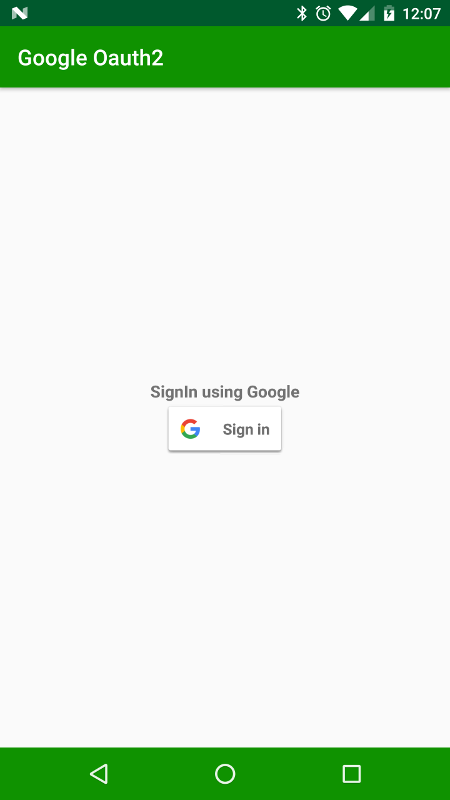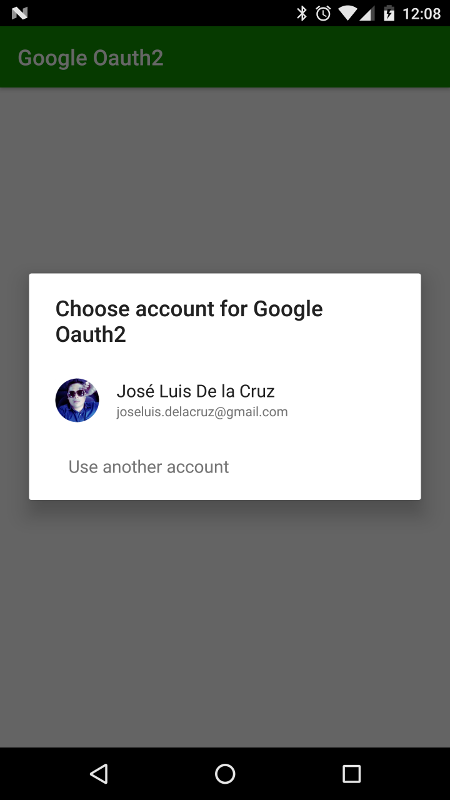This time I will show you how to integrate Google Sing-In to an Android application. First you need to add Google play services SDK. In Android Studio select: Tools > Android > SDK Manager, then in SDK Tools tab check the Google Play Services checkbox button.
Create a new project in android studio with an empty Activity, default options and set the following dependencies in build.gradle
apply plugin: 'com.android.application'
android {
compileSdkVersion 25
buildToolsVersion "26.0.0"
defaultConfig {
applicationId "com.jos.dem.oauth2"
minSdkVersion 21
targetSdkVersion 25
versionCode 1
versionName "1.0"
testInstrumentationRunner "android.support.test.runner.AndroidJUnitRunner"
}
buildTypes {
release {
minifyEnabled false
proguardFiles getDefaultProguardFile('proguard-android.txt'), 'proguard-rules.pro'
}
}
}
dependencies {
compile fileTree(dir: 'libs', include: ['*.jar'])
androidTestCompile('com.android.support.test.espresso:espresso-core:2.2.2', {
exclude group: 'com.android.support', module: 'support-annotations'
})
compile 'com.android.support:appcompat-v7:25.3.1'
compile 'com.android.support.constraint:constraint-layout:1.0.2'
compile 'com.google.android.gms:play-services-auth:11.0.4' // 2
testCompile 'junit:junit:4.12'
}
apply plugin: 'com.google.gms.google-services' // 1
- Adding Google Services plugin
- Adding Google Play Services Auth
Also in the project’s gradle.properties you need to add Google services
// Top-level build file where you can add configuration options common to all sub-projects/modules.
buildscript {
repositories {
jcenter()
}
dependencies {
classpath 'com.android.tools.build:gradle:2.3.3'
classpath 'com.google.gms:google-services:3.1.0'
// NOTE: Do not place your application dependencies here; they belong
// in the individual module build.gradle files
}
}
allprojects {
repositories {
jcenter()
}
}
task clean(type: Delete) {
delete rootProject.buildDir
}
You will need to get a configuration file, in order to do that follow this instructions: Get a configuration file. At the end of this process you will get an google-services.json copy it to the app directory.
In the activity_main.xml create an Sign-In button and TextView status label components:
<?xml version="1.0" encoding="utf-8"?>
<LinearLayout xmlns:android="http://schemas.android.com/apk/res/android"
android:layout_width="match_parent"
android:layout_height="match_parent"
android:gravity="center"
android:orientation="vertical">
<TextView
android:id="@+id/status"
android:layout_width="wrap_content"
android:layout_height="wrap_content"
android:text="SignIn using Google"
android:textSize="15sp"
android:textStyle="bold"/>
<com.google.android.gms.common.SignInButton
android:id="@+id/sign_in_button"
android:layout_gravity="center"
android:layout_width="wrap_content"
android:layout_height="wrap_content" />
</LinearLayout>

This is the MainActivity:
package com.jos.dem.oauth2;
import android.content.Intent;
import android.support.v7.app.AppCompatActivity;
import android.os.Bundle;
import android.util.Log;
import android.view.View;
import android.widget.TextView;
import com.google.android.gms.auth.api.Auth;
import com.google.android.gms.auth.api.signin.GoogleSignInAccount;
import com.google.android.gms.auth.api.signin.GoogleSignInOptions;
import com.google.android.gms.auth.api.signin.GoogleSignInResult;
import com.google.android.gms.common.ConnectionResult;
import com.google.android.gms.common.SignInButton;
import com.google.android.gms.common.api.GoogleApiClient;
public class MainActivity extends AppCompatActivity implements GoogleApiClient.OnConnectionFailedListener, View.OnClickListener {
private static final int RC_SIGN_IN = 9001;
private static final String TAG = "Oauth2Google";
private GoogleApiClient googleApiClient;
private TextView statusTextView;
private SignInButton signInButton;
@Override
protected void onCreate(Bundle savedInstanceState) {
super.onCreate(savedInstanceState);
setContentView(R.layout.activity_main);
statusTextView = (TextView) findViewById(R.id.status);
GoogleSignInOptions gso = new GoogleSignInOptions.Builder(GoogleSignInOptions.DEFAULT_SIGN_IN) // 1
.requestEmail()
.build();
googleApiClient = new GoogleApiClient.Builder(this) // 2
.enableAutoManage(this, this)
.addApi(Auth.GOOGLE_SIGN_IN_API, gso)
.build();
signInButton = (SignInButton) findViewById(R.id.sign_in_button);
signInButton.setOnClickListener(this);
}
@Override
public void onClick(View view) {
signIn();
}
private void signIn() {
Intent signInIntent = Auth.GoogleSignInApi.getSignInIntent(googleApiClient); // 3
startActivityForResult(signInIntent, RC_SIGN_IN);
}
@Override
public void onConnectionFailed(ConnectionResult connectionResult) {
Log.d(TAG, "onConnectionFailed:" + connectionResult);
}
@Override
public void onActivityResult(int requestCode, int resultCode, Intent data) {
super.onActivityResult(requestCode, resultCode, data);
if (requestCode == RC_SIGN_IN) {
GoogleSignInResult result = Auth.GoogleSignInApi.getSignInResultFromIntent(data); // 4
handleSignInResult(result);
}
}
private void handleSignInResult(GoogleSignInResult result) {
Log.d(TAG, "handleSignInResult:" + result.isSuccess());
if (result.isSuccess()) {
GoogleSignInAccount account = result.getSignInAccount();
statusTextView.setText("Signed as: " + account.getEmail());
signInButton.setVisibility(View.GONE);
} else {
statusTextView.setText("Signed in unsuccessfully");
}
}
}
This is the Sign-In Google Intent:

- A
GoogleSignInOptionsobject with theDEFAULT_SIGN_INparameter and requesting users’ email addresses as well with therequestEmail()option. - A
GoogleApiClientobject with access to the Google Sign-In API.enableAutoManagerequiresFragmentActivityorAppCompatActivityas first parameter andOnConnectionFailedListeneras second parameter, in our case this will be both ourMainActivity. - Prompts the user to select a Google account to sign in with.
onActivityResultmethod, retrieve the sign-in result withgetSignInResultFromIntent.
Here is when we handleSignInResult:

To download the code:
git clone https://github.com/josdem/android-google-oauth2.git